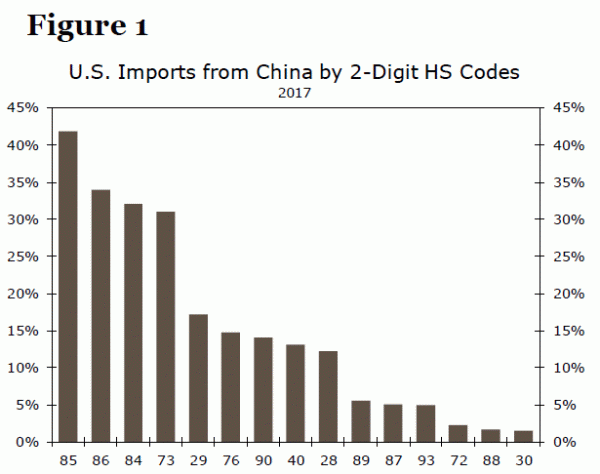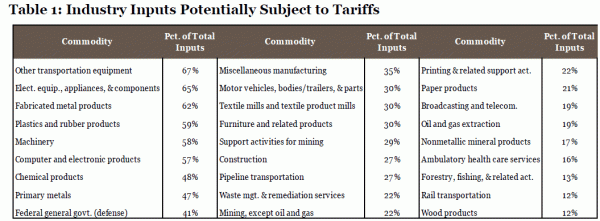Executive Summary
We focus in this report on how potential American tariffs on Chinese goods could affect the supply chains of different industries. Not only would tariffs directly raise the prices of Chinese-produced goods, but non-Chinese producers of those goods could use the opportunity to raise their prices. We find that the aircraft manufacturing industry is among the industries with the most exposure to inputs that are targets of potential tariffs. But there are some not-so-readily apparent industries that could also see the prices of many of their inputs rise.
Is China a Major Supplier of Potentially Tariffed Goods?
The news media has been filled in recent weeks with stories of proposed American tariffs on Chinese goods and Chinese threats of retaliation. Chinese President Xi made a speech recently that was conciliatory in nature, so some of the tension between the United States and China has been reduced, at least for now. That said, the situation is fluid and it would be premature to claim categorically that both sides will not resort to tariff implementation. In three previous reports, we analyzed the vulnerability of specific American industries to potential tariff retaliation, which countries could be affected indirectly by U.S. tariffs on Chinese goods and the potential costs of a full-blown trade war.1 In this report, we focus on the effects that American tariffs on Chinese goods could have on specific industries in the United States to determine how the tariffs could affect the supply chains of different industries.
On April 3, the Office of the U.S. Trade Representative (USTR) released a list of proposed tariffs on 1,300 Chinese goods that have a total import value of roughly $50 billion. The goods are classified according to the Harmonized Commodity Description and Coding System (HS), and they can be broadly grouped into imports of the following goods: chemicals and pharmaceutical products, (HS 28, 29 & 30), rubber and articles thereof (HS 40), iron and steel and articles thereof (HS 72 & 73), aluminum and articles thereof (HS 76), machinery (HS 84, 85 & 86), vehicles other than railway (HS 87), aircraft and parts (HS 88), ships and boats (HS 89), optical and other types of equipment (HS 90) and arms and ammunition (HS93)2. Note that many of these broad categories of goods are not consumed directly by consumers but rather are used as inputs into the production of other goods in the United States.
If implemented, the measures announced by the USTR would directly raise the price of the Chinese goods that are subject to the tariffs. But they would also encourage non-Chinese producers of the goods, whether in the United States or in other foreign economies, to raise prices as well. For goods for which China is not an important supplier, prices probably would not rise that much. But for goods for which China is a major supplier, prices could rise meaningfully. In that regard, Figure 1 shows that the United States gets 30 percent or more of its imports of the following goods from China: electric machinery (HS 85), railway machinery (HS 86), nuclear reactors and other machinery (HS 84) and articles of iron and steel (HS 73).3 Consequently, prices of these products could rise in a meaningful way if the United States goes through with its stated intention of enacting tariffs on these goods.
 Some Industries Are Apparent, Some Not So Much
Some Industries Are Apparent, Some Not So Much
So which industries in the United States would potentially bear the brunt of higher costs of inputs? To answer this question, we turned to the input-output tables of the U.S. economy. These tables are useful because they contain data on the inputs that are required to produce the output of 71 individual industries. We started by isolating the goods noted above that are potentially subject to tariffs. For each of the 71 industries, we then summed the dollar value of these tariff-affected goods and expressed them as a percent of total inputs of each industry. Finally, we ordered the 71 industries in descending order of percentages. The results for the industries with percentages in excess of 10 percent are shown in Table 1.
 Our analysis shows that the “other transportation equipment” industry, which is essentially aircraft manufacturing, is the industry with the most exposure to inputs that are targets of potential tariffs. That is, 67 percent of the inputs of the aircraft manufacturing industry are at risk of higher prices, either directly or indirectly, from the announced list of tariffs. Other industries with high degrees of exposure to the price-raising effects of tariffs include electrical equipment, appliances & components, fabricated metal products, plastic and rubber products, machinery, computer and electronic products, chemicals and primary metals.
Our analysis shows that the “other transportation equipment” industry, which is essentially aircraft manufacturing, is the industry with the most exposure to inputs that are targets of potential tariffs. That is, 67 percent of the inputs of the aircraft manufacturing industry are at risk of higher prices, either directly or indirectly, from the announced list of tariffs. Other industries with high degrees of exposure to the price-raising effects of tariffs include electrical equipment, appliances & components, fabricated metal products, plastic and rubber products, machinery, computer and electronic products, chemicals and primary metals.
It is notable that there is some overlap between goods subject to tariffs and industries that have high degrees of exposure to those goods. But this makes sense upon further reflection. For example, many chemicals are potentially subject to the announced tariffs, but our analysis also shows that many chemical producers are highly vulnerable to higher costs via inputs of other chemicals. We are not experts on the chemical industry, but certain types of chemicals probably are important inputs into the production of other types of chemicals. Likewise, the electrical equipment industry uses significant amounts of other types of electrical equipment (e.g., integrated circuit boards) in its production process.
An “industry” that is listed in Table 1 that bears mentioning is “federal government defense.” Indeed, 41 percent of the “inputs” of this “industry” are at risk of higher prices from tariffs. Although the Department of Defense likely does not buy many goods directly from China, the prices of the goods that it buys from competing American producers (e.g., iron and steel products, electrical equipment, etc.) could be pushed up meaningfully if those producers take the opportunity of tariffs on Chinese goods to raise their own prices. This is an example of the potential negative effect that tariffs could have on an “industry,” which would not be readily apparent from casual observation. The construction industry, which may not spring readily to mind as an industry that could have its supply chain affected by tariffs, is also vulnerable to higher costs of many of its major inputs.
Conclusion
A few weeks ago, the USTR released a list of 1,300 Chinese goods that could potentially be subject to tariffs. These tariffs have not yet gone into effect, because they are subject to a public comment period. Moreover, the administration could eventually decide not to impose the tariffs if negotiations with China are successful. But if the tariffs are ultimately enacted, then certain American industries could be facing higher costs of important inputs, either directly or indirectly.
Our analysis shows that the aircraft manufacturing industry is among the industries with the most exposure to inputs that are targets of potential tariffs. Other industries with high degrees of potential exposure include manufacturers of electrical equipment, appliances & components, fabricated metal products, plastic and rubber products, machinery, computer and electronic products, chemicals and primary metals. But there are other “industries,” which are not so readily apparent, that could face higher costs if the tariffs are enacted. For example, the U.S. Department of Defense and the construction industry could be negatively affected if the prices of the goods they buy rise on account of the tariffs.












